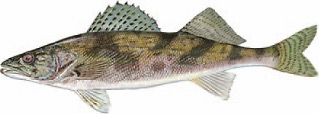 Scientific Name
Scientific Name
Sander canadensis
Other Common Names
sand pike, jack salmon
Identification
A member of the perch family, very similar to walleye. Its best identifying marks are its spotted spiny dorsal. Its body colors are more of a dusky-brown to yellowish-olive, with large, irregular patches on its side, peppered in between with smaller dark markings and a white underside. Very slim build in comparison to walleye. Has a silvery, reflective eye similar to the walleye’s, and a mouth full of canine teeth. When handled, it flares out its gills, flattens its head and shivers as if bracing itself for the hook removal. Typically 10 to 19 inches.
Best Fishing
Rivers: Clinch and Powell.
Fishing Techniques
Minnows are the best bait. Sauger tend to feed on or near the bottom. Some of the best fishing is below dams in the tailwaters. Early morning and evening are best times. They will hit fairly large minnows and are “lazy” hitters. Are quite adept at “stealing” bait. Will hit spoons, jigs or spinners, especially if tipped with a minnow.
Feeding Habits
They feed on small fishes, insects and insect larvae, and crustaceans. Tend to feed on or near the bottom
Habitat
A fish of larger lakes and rivers that is tolerant of a certain degree of turbidity. Favors deeper channels or old river beds, and tailrace waters of dams. In Virginia it inhabits the rivers of the Tennessee drainage.
Spawning Habits
From March to May, usually in shallows over rocky reefs, or along sandy shores or shoals where water action aerates its eggs. It may also spawn in the deep rocky runs of rivers Semi buoyant eggs are scattered amid rocks, fertilized by the males as they are released.

